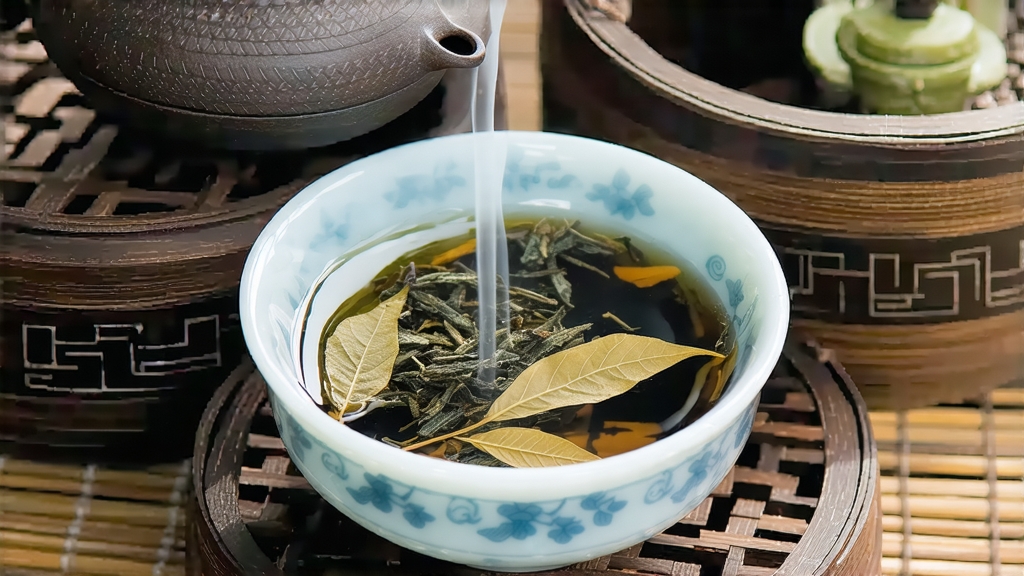
Liu Bao cha, literally “Six Forts tea,” is the southern sentinel of China’s dark tea family. While Yunnan’s pu-erh steals headlines, this subtropical cousin from Guangxi has been quietly ferrying flavor across centuries, first along the 2,000-year-old Tea-Horse Road and later aboard bamboo rafts down the Xunjiang River to Hong Kong and Southeast Asia. Its story begins in the small county of Wuzhou, where low hills, red clay soil, and a humidity that clings like silk create the perfect cradle for a tea designed to age, voyage, and evolve.
Historical records first name Liu Bao during the Qing dynasty’s Jiaqing reign (1796–1820), when the imperial court listed it among the “64 famous teas” eligible for tribute. Yet villagers in the Liù Bǎo township insist their grandfathers’ grandfathers already pressed the leaf into baskets during the Ming, trading it for salt, copper, and Tibetan horses. Compressed into tight bamboo baskets lined with wild taro leaves, the tea withstood mold, monsoon, and the sweat of porters to arrive in Kuala Lumpur’s tin-mine canteens, where Indian, Malay, and Chinese laborers drank it to cut the grease of coconut rice and to soothe fever. In the 1970s, Malaysian tin prices collapsed, but Liu Bao stayed, quietly aging in shop houses until a new generation of tea hunters rediscovered its cask-like smoothness and began calling it “the drinkable antique.”
Unlike pu-erh’s two paths—raw and ripe—Liu Bao walks only the fully fermented road. The leaf itself is a medium-leaf cultivar, neither the Yunnan big leaf nor the Fujian bush, but something in between: oval, thick, and faintly serrated, able to withstand a month-long steam bath without collapsing. After spring picking, the leaves wither under subtropical sun for two hours, just long enough for the grassy note to retreat. They are then wok-fired at 280 °C for eight minutes, a violent kiss that fixes the dark jade color and awakens a nutty aroma reminiscent of grilled rice. While still warm, workers pile the leaves into bamboo trays and roll them twice—first lightly to break cell walls, then aggressively to twist the leaf into a snail curl that will later trap humidity.
The signature step is “wet piling,” Guangxi’s answer to Yunnan’s wo dui. A 1.2-meter-tall heap is sprayed with mountain water, covered with jute sacks, and left to ferment for 25–35 days. Microbes indigenous to the region—Bacillus wuzhouensis, Aspergillus liubaoensis—thrive in the 28 °C heat, turning the leaf from olive to espresso brown and transforming bitter catechins into mellow theabrownins. Every three days the pile is turned, allowing oxygen to moderate the fermentation and preventing the sour note that once plagued river-boat teas. When the master detects a scent of dried longan mixed with wet earth, he declares the pile “alive,” and spreads the leaves under sun and mountain wind to dry.
Traditionally the tea is packed into 40-kilogram bamboo baskets lined with a single taro leaf. The taro’s microscopic hairs act as a one-way valve, letting humidity escape while blocking insects. Over decades the basket breathes, and the tea inside oxidizes slowly, trading its youthful betel-nut bite for camphor, sandalwood, and finally a dark honey note that lingers on the palate like a cello chord. Modern producers also press Liu Bao into 357-gram cakes and 100-gram mini bricks, convenient for urban storage yet still capable of the same metamorphosis.
To brew Liu Bao is to converse with time. Begin by awakening the leaf: break off 5 grams from the basket’s edge—never the core, where compression is densest—and place it in a warmed Yixing pot or a 150-milliliter gaiwan. Flash-rinse with 95 °C water for three seconds, discarding the liquor while inhaling the rising steam; the first scent is often of petrichor after a summer storm. Subsequent infusions start at five seconds, adding one second each round. The first three cups reveal the tea’s “shadow soul”: bitter cocoa that vanishes into a sweet, cooling throat. By the fifth infusion the leaf relaxes, releasing dark-fruit notes—blackcurrant, dried jujube—